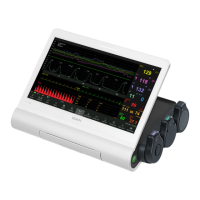F15 Series Fetal & Maternal Monitor User Manual Alarms
- 66 -
A different cuff other than the one
supplied by the manufacturer is
used.
Use the cuff supplied by the
manufacturer.
The cuff, hose and (or) connector
are (is) damaged.
Check and replace the leaking part(s).
Contact the manufacturer for service if
required.
Cuff is too loose or the patient
pulse is too weak.
Use other methods to measure NIBP.
Large signal noise or irregular
pulse rate caused by excessive
motions of the patient.
Keep the arm that is wrapped with the cuff
still.
NIBP EXCEEDS
MEASUREMENT
RANGE
The blood pressure exceeds the
measurement limits.
Check the connection of the cuff and the
patient’s condition.
Measuring time has exceeded
120 seconds.
Start measuring again, or use other
measuring methods.
The signal received by SpO
2
sensor is too weak, or the
measurement part has low
perfusion, and therefore the result
may be inaccurate.
Check the patient’s condition and
reposition the SpO
2
sensor. Contact the
manufacturer for service if the problem
persists.
SpO
2
sensor is not well
connected.
Check the connection of SpO
2
sensor and
finger placement.
The SpO
2
board cannot
communicate with the system
successfully.
Restart the monitor and try again, contact
the manufacturer if the connection still
fails.
TEMP transducer is not well
connected.
Check the connection of TEMP
transducer.
TEMP EXCEEDS
MEASUREMENT
RANGE
The temperature exceeds the
measurement limits.
Check the connection of the TEMP
transducer and the patient’s condition.
Calibration of the TEMP
transducer failed.
Restart the monitor and try again. Contact
the manufacturer for service if the
problem persists.
Abnormal network traffic has been
detected. The data traffic exceeds
the limit.
Disconnect the network to make the
monitor work properly, and then contact
the professionals authorized by
manufacturer to check the network
problem.
4.18.3 FTS-3 Technical Alarm Messages
When FTS-3 is connected to F15 series fetal/maternal monitor, the monitor gives
technical alarms for the situations that need the physicians to pay attention to during
wireless monitoring, the alarm messages are listed below.
Traditional 510(k) of Fetal & Maternal Monitor
014_14.1_F15_Series_User_Manual

